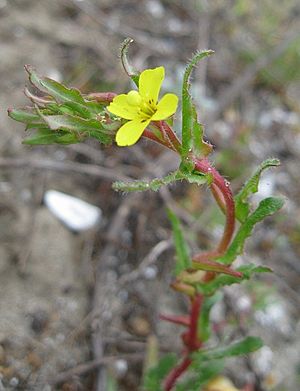Lewis' evening primrose facts for kids
Quick facts for kids Lewis' evening primrose |
|
|---|---|
 |
|
| Scientific classification | |
| Genus: |
Camissoniopsis
|
| Species: |
lewisii
|
| Synonyms | |
|
|
Camissoniopsis lewisii is a type of plant often called Lewis' evening primrose. It belongs to the evening primrose family. This plant naturally grows in southern California and Baja California. You can find it in places like coastal areas and the grassy fields of inland mountains. For example, in Baja California, it often grows near other plants like Mimulus aridus and Adiantum jordanii.
What is Lewis' Evening Primrose?
Lewis' evening primrose is an annual plant. This means it completes its whole life cycle in just one year. It grows from a seed, flowers, produces new seeds, and then dies, all within a single season.
How Does It Look?
This plant has a stem that can grow up to about half a meter tall. The stem is often covered in tiny hairs. Sometimes the stem stands straight up without branches. Other times, it spreads out along the ground and grows many branches.
The leaves of the plant are mostly found in a circle at the bottom. This circle of leaves is called a basal rosette. These bottom leaves can be several centimeters long. You will also find some smaller leaves growing along the stem.
Its Flowers and Fruit
The flowers of Lewis' evening primrose grow in a cluster. When they are ready to bloom, the flower buds often nod downwards. Each flower has bright yellow petals. These petals are usually only a few millimeters long. Look closely, and you might see one or two small red spots at the base of each petal.
After the flowers bloom, the plant produces a fruit. This fruit is shaped like a coil. It is usually about one to two centimeters long. Inside the fruit are the seeds that will grow into new plants next year.

